

General
The Dutch Leeward islands, Aruba, Curaçao and Bonaire (ABC Islands), extend from 68 to 70 degrees West and from 1The Dutch Leeward Islands
General
The Dutch Leeward islands, Aruba, Curaçao and Bonaire (ABC Islands), extend from 68 to 70 degrees West and from 12 to 13 degrees North. These islands are situated in the so called Southern Caribbean Dry Zone, and are characterized by their semi-arid to arid climate (BS for Bonaire and Curaçao and BW for Aruba on the classification scheme of Köppen), with a distinguishable dry and rainy season, and sustained moderate to fresh easterlies. The dry season runs from February through May, whereas the rainy season starts in October and ends in January. The months of August and September can be considered as transitional months. During the rainy season the rain showers occur usually during the early morning or early to late evening hours. The climate on these islands sets itself apart from the climate at comparable latitudes due to the very often light, undependable nature of the rains (thunderstorms mainly occur in October, with the climatic average of this month equal to 7 days a month) and their suppression during the high-sun (northern hemisphere summer) months, when ordinarily precipitation at these latitudes is at its maximum. The cause of this altered climatic nature with respect to regions located at the same latitude has been postulated to a combination of factors. These are among others:
- The proximity of the islands to the southern mainland;
- The presence of the Venezuelan northern cordilleras ,and
- The western end of the Azores subtropical high.
To this date research is being conducted with respect to this particularity, with no conclusive results. Furthermore the islands are characterized by warm tropical temperatures with the highest mean temperatures occurring in September. The seawater around the islands averages around 27°C and are coldest (Av. 25.9°C ) around February-March and warmest (Av. 28.2°C) around September-October. The skies are in general mostly clear to partly cloudy.
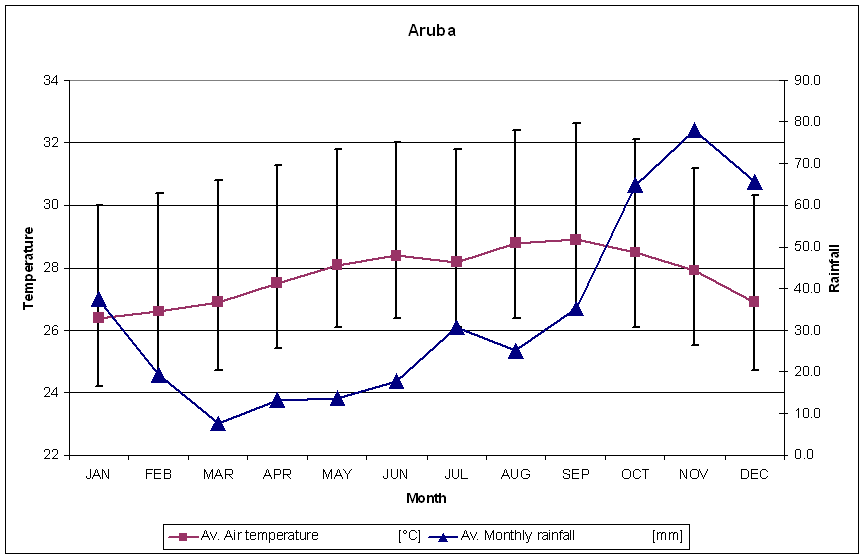 Climate summary |
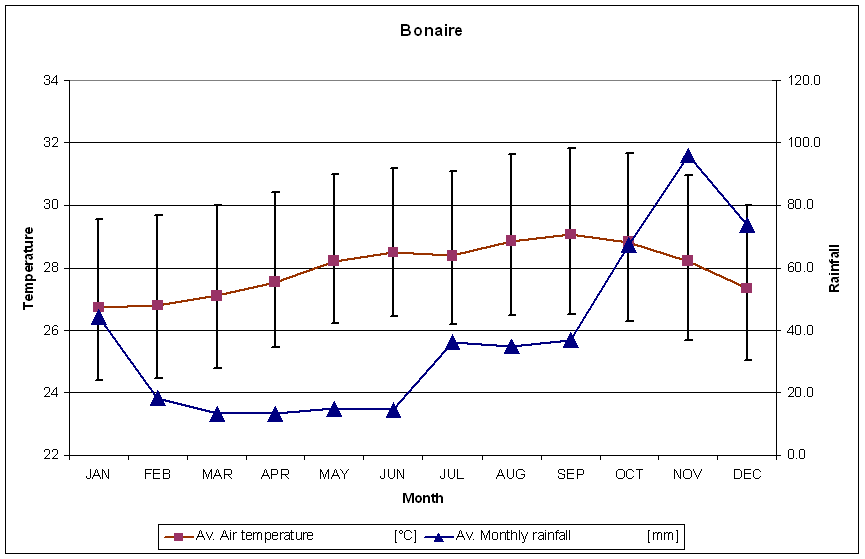 Climate summary |
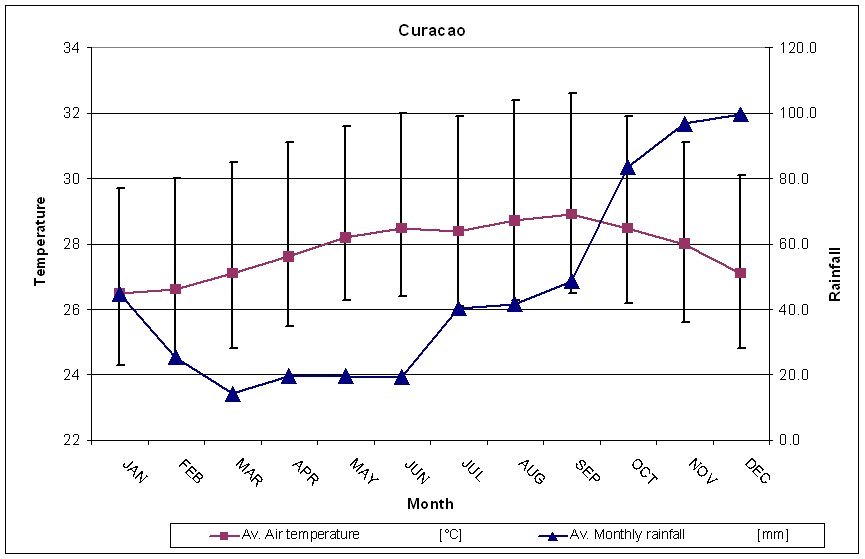 Climate summary |
The Dutch Windward Islands
General
The Dutch Windward islands, St. Maarten, St. Eustatius and Saba (SSS Islands), are located around 63 degrees West and extend from 17.5 to 18.5 degrees North. The islands are characterized by a marine climate (Am on the classification scheme of Köppen). The climate of these islands is characterized by a relatively dry season (January-April) and a rainy season (August-December), with moderate to fresh east to northeasterlies. Showers occur most of the time during the late afternoon. These climatic conditions can mainly be attributed to the displacement of the Azores subtropical ridge during the year. However, local effects are also very significant on these islands, especially on Saba. During the northern hemisphere summer, the Azores subtropical high is located more to the south over the central Atlantic and suppresses the formation of clouds that can produce rain. Showers are limited and of light intensity during these months. As the northern autumn approaches, the Azores subtropical high retracts to a more northern position, moving away from the islands. Its influence on the atmosphere above the islands diminishes and hence making significant cloud formation and rain possible. These showers are moderate to heavy of character and can often be accompanied by thunder. Furthermore the islands experience tropical temperatures (Av. 27 °C) with August being the warmest month. The seawater around the islands averages around 27.2 °C, and skies are in general mostly clear to partly cloudy.
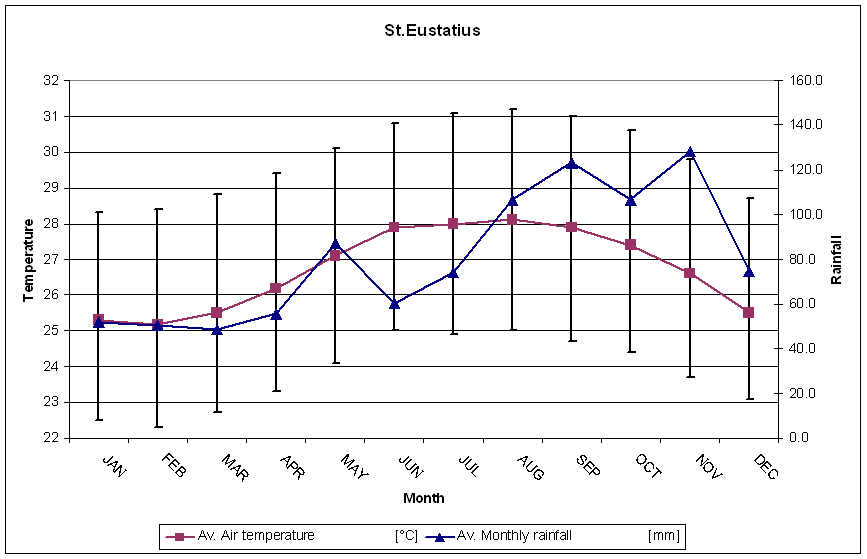 Climate summary |
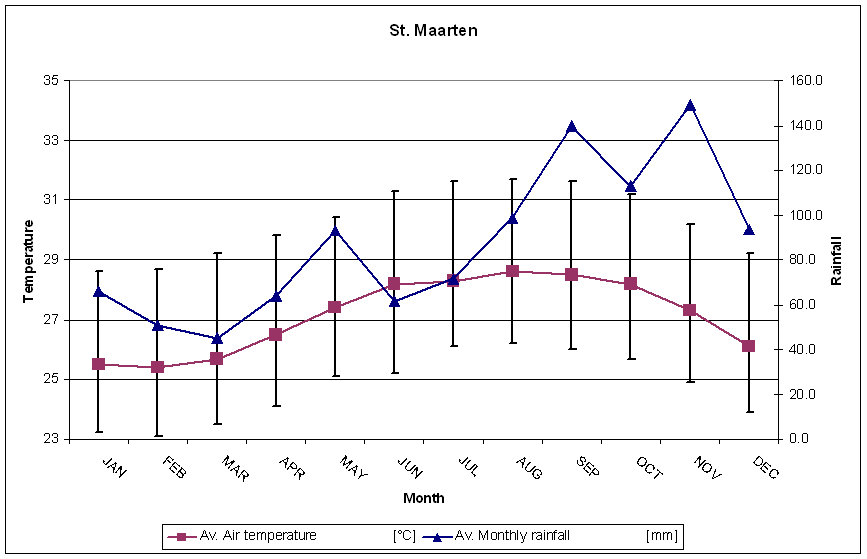 Climate summary |
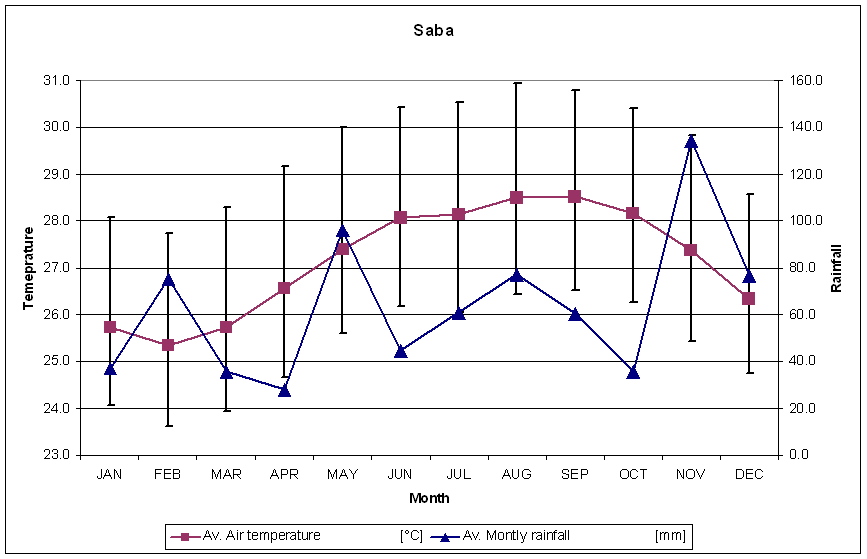 Climate summary |
Tropical Cyclones
The hurricane season runs from June 1st to November 30th, with a peaked season from August through October. The Dutch Leewards are located on the southern boundary of the Atlantic hurricane region, whereas the Dutch Windward Islands are situated within the Atlantic hurricane region. Climatic records show that merely 15 tropical cyclones (TC) (Tropical Storms up to Category 5 Hurricanes) passed near the islands of Aruba, Curaçao and Bonaire within a distance of 120 nautical miles on either the southern or northern side of the islands during the period 1851-2009. For the Dutch Windward Islands, 64 hurricanes passed within 120 nautical miles on either side of the islands during the same period.
Although the hurricane experience level for the ABC-Islands may be regarded as very limited, well known is the minor hurricane which passed just south of Curaçao on September 23, 1877, causing an estimated structural damage of US$ 2 million, mainly to the coastal section of Willemstad. A nunnery was completely washed away; its remnants are still visible at low tide. Numerous ships were lost and at least 70 deaths were reported. This hurricane is also known as hurricane Tecla, after a nun who was living at the nunnery at the time. She turned out to be the sole survivor of this hurricane at this location. The most significant TC event in the recent years is tropical storm Joan, which passed just south of the ABC-Islands on October 16, 1988, causing an estimated structural damage of approximately US$1.5 million. The damage was mainly due to rough winds, which blew off many rooftops and rough seas pounding exposed harbor and beach facilities. Excessive rains in the aftermath of Joan also caused widespread flooding over the islands that lasted for several days.
The SSS-Islands however have more experience with hurricanes since once every 4-5 years on average, hurricane conditions are experienced. In recent years there have been several events that brought considerable damage to the islands. One of the most catastrophic ones for the SSS-Islands, was Hurricane Luis in 1995. The center of hurricane Luis passed at approximately 55 km north of St. Maarten in the early evening of September 5, 1995, moving in a west-northwesterly direction. Fortunately, due to a well-functioning warning system and very timely warnings, only a very limited amount of casualties was experienced (official records: two deaths). The damage, especially on the island of St. Maarten, was extensive. The total damage was estimated to be approximately US$1 billion (direct and indirect). Over 90% of all construction was damaged or had been completely destroyed. Nearly all power and telephone lines were damaged and out of operation, leaving the island for several days without communication with the rest of the world. Saba and St. Eustatius experienced considerable less damage than St. Maarten, since the most intense part of the hurricane stayed to the north of these islands. (For more details on the hurricane climatology of the Dutch Caribbean Islands please check out our publication on Hurricanes and Tropical Storms in the Netherlands Antilles and Aruba.).
- The proximity of the islands to the southern mainland;
- The presence of the Venezuelan northern cordilleras ,and
- The western end of the Azores subtropical high.
To this date research is being conducted with respect to this particularity, with no conclusive results. Furthermore the islands are characterized by warm tropical temperatures with the highest mean temperatures occurring in September. The seawater around the islands averages around 27°C and are coldest (Av. 25.9°C ) around February-March and warmest (Av. 28.2°C) around September-October. The skies are in general mostly clear to partly cloudy.
 Climate summary |
 Climate summary |
 Climate summary |
The Dutch Windward Islands
General
The Dutch Windward islands, St. Maarten, St. Eustatius and Saba (SSS Islands), are located around 63 degrees West and extend from 17.5 to 18.5 degrees North. The islands are characterized by a marine climate (Am on the classification scheme of Köppen). The climate of these islands is characterized by a relatively dry season (January-April) and a rainy season (August-December), with moderate to fresh east to northeasterlies. Showers occur most of the time during the late afternoon. These climatic conditions can mainly be attributed to the displacement of the Azores subtropical ridge during the year. However, local effects are also very significant on these islands, especially on Saba. During the northern hemisphere summer, the Azores subtropical high is located more to the south over the central Atlantic and suppresses the formation of clouds that can produce rain. Showers are limited and of light intensity during these months. As the northern autumn approaches, the Azores subtropical high retracts to a more northern position, moving away from the islands. Its influence on the atmosphere above the islands diminishes and hence making significant cloud formation and rain possible. These showers are moderate to heavy of character and can often be accompanied by thunder. Furthermore the islands experience tropical temperatures (Av. 27 °C) with August being the warmest month. The seawater around the islands averages around 27.2 °C, and skies are in general mostly clear to partly cloudy.
 Climate summary |
 Climate summary |
 Climate summary |
Tropical Cyclones
The hurricane season runs from June 1st to November 30th, with a peaked season from August through October. The Dutch Leewards are located on the southern boundary of the Atlantic hurricane region, whereas the Dutch Windward Islands are situated within the Atlantic hurricane region. Climatic records show that merely 15 tropical cyclones (TC) (Tropical Storms up to Category 5 Hurricanes) passed near the islands of Aruba, Curaçao and Bonaire within a distance of 120 nautical miles on either the southern or northern side of the islands during the period 1851-2009. For the Dutch Windward Islands, 64 hurricanes passed within 120 nautical miles on either side of the islands during the same period.
Although the hurricane experience level for the ABC-Islands may be regarded as very limited, well known is the minor hurricane which passed just south of Curaçao on September 23, 1877, causing an estimated structural damage of US$ 2 million, mainly to the coastal section of Willemstad. A nunnery was completely washed away; its remnants are still visible at low tide. Numerous ships were lost and at least 70 deaths were reported. This hurricane is also known as hurricane Tecla, after a nun who was living at the nunnery at the time. She turned out to be the sole survivor of this hurricane at this location. The most significant TC event in the recent years is tropical storm Joan, which passed just south of the ABC-Islands on October 16, 1988, causing an estimated structural damage of approximately US$1.5 million. The damage was mainly due to rough winds, which blew off many rooftops and rough seas pounding exposed harbor and beach facilities. Excessive rains in the aftermath of Joan also caused widespread flooding over the islands that lasted for several days.
The SSS-Islands however have more experience with hurricanes since once every 4-5 years on average, hurricane conditions are experienced. In recent years there have been several events that brought considerable damage to the islands. One of the most catastrophic ones for the SSS-Islands, was Hurricane Luis in 1995. The center of hurricane Luis passed at approximately 55 km north of St. Maarten in the early evening of September 5, 1995, moving in a west-northwesterly direction. Fortunately, due to a well-functioning warning system and very timely warnings, only a very limited amount of casualties was experienced (official records: two deaths). The damage, especially on the island of St. Maarten, was extensive. The total damage was estimated to be approximately US$1 billion (direct and indirect). Over 90% of all construction was damaged or had been completely destroyed. Nearly all power and telephone lines were damaged and out of operation, leaving the island for several days without communication with the rest of the world. Saba and St. Eustatius experienced considerable less damage than St. Maarten, since the most intense part of the hurricane stayed to the north of these islands. (For more details on the hurricane climatology of the Dutch Caribbean Islands please check out our publication on Hurricanes and Tropical Storms in the Netherlands Antilles and Aruba.).
